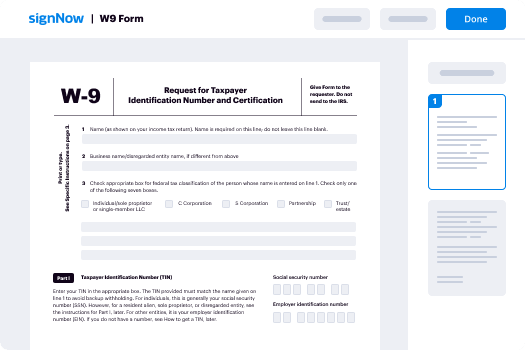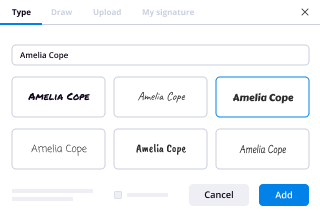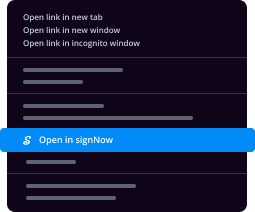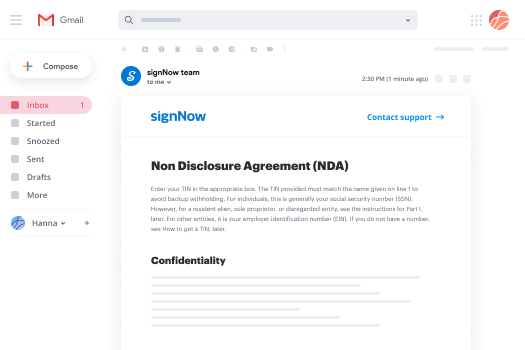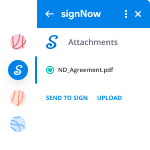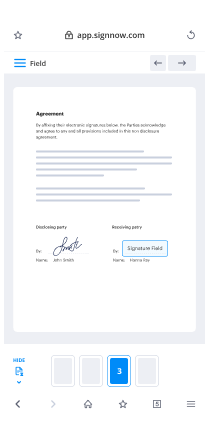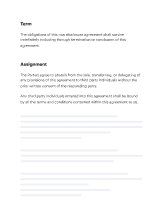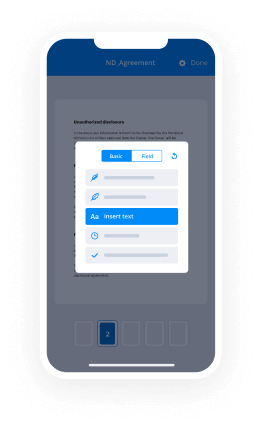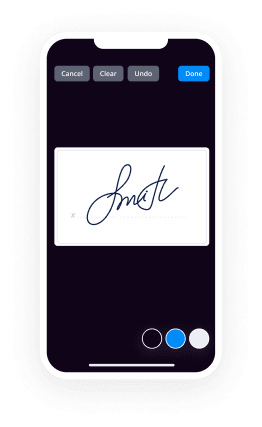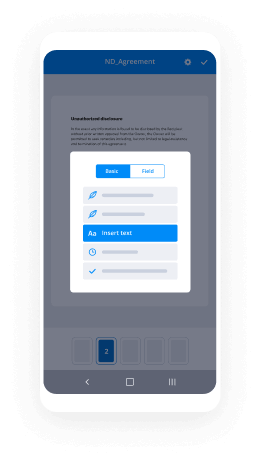How To Add eSign in Word
Contact Sales
Make the most out of your eSignature workflows with airSlate SignNow
Extensive suite of eSignature tools
Robust integration and API capabilities
Advanced security and compliance
Various collaboration tools
Enjoyable and stress-free signing experience
Extensive support
Keep your eSignature workflows on track
Our user reviews speak for themselves






How to incorporate e-signature in Word
In the contemporary digital landscape, understanding how to incorporate e-signature in your documents can greatly optimize your workflow. With airSlate SignNow, you can effortlessly transmit and sign documents electronically, boosting efficiency and minimizing turnaround time. This guide will direct you through the uncomplicated steps to incorporate e-signatures into your documents smoothly.
How to incorporate e-signature in Word using airSlate SignNow
- Launch your web browser and go to the airSlate SignNow homepage.
- Create a complimentary trial account or sign in if you already have one.
- Select the document you intend to sign or send for signing by uploading it to the platform.
- If you plan to utilize this document regularly, save it as a template for later use.
- Access your file and modify it by adding fillable fields or extra information as necessary.
- Insert your signature and assign signature fields for the recipients.
- Click 'Continue' to arrange the eSignature invitation and send it out.
By adhering to these straightforward steps, you can effortlessly incorporate e-signature in your documents, enhancing both your productivity and professionalism. airSlate SignNow not only simplifies the signing process but also provides a variety of features tailored to accommodate the needs of small to mid-sized businesses.
Ready to optimize your document signing procedure? Begin your free trial with airSlate SignNow today and enjoy the advantages of transparent pricing, outstanding customer support, and a comprehensive feature set designed for your business requirements.
How it works
Rate esign download
-
Best ROI. Our customers achieve an average 7x ROI within the first six months.
-
Scales with your use cases. From SMBs to mid-market, airSlate SignNow delivers results for businesses of all sizes.
-
Intuitive UI and API. Sign and send documents from your apps in minutes.
A smarter way to work: —how to industry sign banking integrate
FAQs
-
How do I add an e-signature to my documents using airSlate SignNow?
To learn how to add e sign word to your documents using airSlate SignNow, simply upload your document, select the e-signature field, and drag it to the desired location. You can easily customize the signature options, ensuring a seamless signing experience for both you and your recipients.
-
What features does airSlate SignNow offer for e-signatures?
airSlate SignNow provides a variety of features that simplify how to add e sign word, including customizable templates, real-time tracking of document status, and automated workflows. Additionally, it supports multiple signing methods and secure storage, making it a comprehensive solution for e-signatures.
-
Is airSlate SignNow affordable for small businesses?
Yes, airSlate SignNow is designed to be cost-effective, especially for small businesses looking for ways on how to add e sign word without breaking the bank. With competitive pricing plans and a range of features, you can find a solution that fits your budget while still gaining access to powerful e-signature capabilities.
-
Can I integrate airSlate SignNow with other applications?
Absolutely! airSlate SignNow integrates seamlessly with various applications, making it easy to learn how to add e sign word within your existing workflows. Popular integrations include Google Drive, Salesforce, and Microsoft Office, allowing you to enhance productivity and streamline document management.
-
What are the benefits of using airSlate SignNow for e-signatures?
Using airSlate SignNow for e-signatures offers numerous benefits, including increased efficiency, improved document security, and enhanced customer satisfaction. By understanding how to add e sign word to your documents, you can speed up transaction times and ensure that your agreements are legally binding.
-
Is it easy to use airSlate SignNow for new users?
Yes, airSlate SignNow is user-friendly, making it simple for new users to learn how to add e sign word. The intuitive interface guides you through the process of uploading documents, adding signatures, and sending them out for signing, ensuring a smooth experience from start to finish.
-
What types of documents can I sign with airSlate SignNow?
You can use airSlate SignNow to sign a wide variety of documents, including contracts, agreements, and forms. Knowing how to add e sign word to these documents allows you to handle everything from legal contracts to internal memos efficiently and securely.
-
What are some tips and tricks to help remember the rules of German grammar?
1) As a beginner, don't clog your brain with declensions. Focus on what you need in order to get your point across, i. e. other grammar rules, conjugations and lots of vocabulary. Lower class native speakers don't get declensions right either, so Germans will understand you just fine. 2) Before you learn anything else, learn the forms of "möchte". It's technically conditional mood (the exact translation is "would like"), which means that some textbooks teach it really late, but it's so versatile that it's hard to imagine a conversation without it. Learn it early and use it often. Ich möchte ein Bier. Ich möchte gehen. Möchten Sie mit mir tanzen? Ich möchte morgen das Brandenburger Tor sehen. Etc.3) The key rule for word order is that the main verb comes always in second position, no matter if the first position in a sentence is taken up by the subject (!), place, time, manner or even an entire sub-clause. When there is more than one verb, or in a sub-clause, the verbs pile up at the very end, after every unimportant detail.4) Compared to Romance languages where you have to learn different endings for different types of verbs, German verbs are nice in that the endings always stay the same, barring some common-sense adjustments like not wanting to wind up with unpronounceable consonant clusters. Also, German has less tenses than Spanish or French. There are two difficulties: 'strong' verbs and irregular verbs. Strong verbs change their vowel - but the way they change is usually predictable. Read some tables and you will notice the patterns, just like in English there is "ring - rang - rung", "sing - sang - sung", "sink - sank - sunk", etc. Actually German verbs often have the same vowel changes as English ones if they're related, for example in German the equivalents of the previously-mentioned verbs are "singen - sang - gesungen" and "sinken - sank - gesunken".5) When it comes to the past tense, German is much simpler than English, Spanish or French in that conversations about the past are always in the perfect tense and written texts are always in the preterite tense. The only exception is for auxiliary verbs and modal verbs, which are so common that people don't want to say e. g. "ist gewesen" (perfect) and use "war" (preterite) instead in order to save time. So if you remember war, hatte, konnte, durfte, musste, wollte, you can use the perfect tense for everything else (until such time as you have to write essays in German, and by then you will hopefully have memorized most irregular preterite forms from having read a lot).6) The conditional form of verbs is usually the same as the preterite except with an extra Umlaut: war (was) -> wäre (would be)hatte (had) -> hätte (would have)konnte (was able) -> könnte (would be able)durfte (was allowed) -> dürfte (would be allowed)musste (had to) -> müsste (would have to)mochte (liked) -> möchte (would like)wurde (became) -> würde (would become)etc.Actually, you shouldn't need any apart from the ones I listed. Ignore the Konjunktiv 1 completely (Germans forget it as soon as they leave high school) and always replace the Konjunktiv 2 with "würde" + infinitive. Unless you're going for a career in journalism, that's all you'll ever need. 7) When you learn declensions, familiarize yourself with the forms of der, die, das. Pay particular attention to how the "das" forms are almost the same as the "der" forms except in the Accusative (it goes back to old Indo-European that the Nominative of a neuter is formed like the Accusative, and German continues that tradition), and how the plural forms are almost the same as the feminine forms except for Dative. Also note how all words ending in -ein get the same endings, no matter if it's ein, kein, mein or whatever.8) When having to decide between Dative and Accusative, there are two fast rules: 1. If there's no preposition and the noun is a thing, it will be Accusative. Dative is only used for people/animals and after some prepositions. Unfortunately people can be either Dative or Accusative. When there is more than one object in a sentence (e. g. I give something to someone), they cannot both be the same case.2. Most prepositions can only be used with one particular case (if you read that some are used with Genitive, ignore that as pedantry and use Dative instead). For those that can be used with either Accusative or Dative, remember that Accusative is for directions and Dative is for static locations, same as in Latin.9) Adjective endings are determined based on not just the case but also the preceding article or lack thereof, with the basic idea being that one of the words has to show the case ending. If the article doesn't allow you to say what case a word is, then the adjective has to tell you. Now it may look very daunting to learn the adjective endings if you stare at huge tables such as the one Greg found, but in fact there's a very simple set of questions you could memorize instead. If you ever respond YES, do what it says and stop, otherwise continue with the next question:Does the adjective stand on its own, without an article? If so, the adjective gets the same ending as the article would have, e. g. die Frau -> deutschE Frau, dem Mann -> deutschEM Mann, etc. Is the article different from its dictionary form? I. e. is it possible to tell the case from it? If so, the adjective doesn't need to indicate the case, it will get the "bland" -en ending.Is the noun plural? If so, the adjective also gets the "bland" -en ending.Finally, is this article different for masculine and neuter? If so, the adjective will end in -e. If not, the adjective will have to show the word gender, so it gets -er for masculine or -es for neuter words.Obviously I never had to memorize these since I'm a native speaker, but my boyfriend did and found that the process of finding the right endings this way became automatic within a few days.Hope you find this helpful!There's a Quora topic "Learning Languages" that doesn't have nearly as many followers as it should have. Consider following it. Also, I have a Quora blog about languages and language-learning: Selected Language Posts.
-
What are some interesting facts about Turkish grammar, syntax, etc.?
Some “interesting” facts about Turkish;1- Since Turkish is an agglutinative language, words are quite suffixed; but this is not the interesting part, because there are a quite number of agglutinative languages out there; but as far as I know, none of them have this rule for words; “vowel harmony”. You can spot many loan words in the language, just because they fail to comply with this harmony.Like; “Aksiyon” doesn’t comply with the rule but “eylem” does. They have the same meaning but one of them is easily spotted that it’s a loan. (“Action”)Of course not all of the complying ones are native Turkish, there are exceptions for both sides. There might be loan words complying coincidentally or some native examples which wouldn’t comply. But again, most of the such native exceptions are actually also loans but from centuries ago and they are rooted in the language.Vowel harmony in short is, the vowels in a word should be of the same type with the first vowel. If the first vowel is “thin”, the following ones must be too. If the first vowel is “round” the others must follow too; and as such. This rule applies to the suffixes as well. Hence there are suffixes which have the same functionality but they have different vowels within.Like;-cı, -cu, -ci, -cü are all the same suffixes; the only difference is that they each suffix only the words which they comply the rule with.Duvar is “wall” and duvarcı is “person whose profession is to build walls”Koru is “wood, forest” and korucu is “ranger”.Kale is “goal” and kaleci is “goalkeeper”.Sömürü is “exploitation” and sömürücü is “exploitative”.Oh well, there’s also a harmony between the consonants too, wouldn’t you think? For example;-çı,-çi, -çu, -çü are all the same suffixes with those above. (Yes that makes 8 different suffixes for the same functionality.) The difference is as you guessed, they suffix the words which end in suitable consonants with them. Like;Kitap is “book” and kitapçı is “person who sells books”Cumhuriyet is “republic” and cumhuriyetçi is “republican”Top is “ball” and topçu is “person who plays well with balls or whose profession is football”Süt is milk and sütçü is “person who sells milk”.2- This agglutination also brings another interesting thing; very short or “one-word” sentences or expressions. Like;Yapamayabilirim. (I may not be able to do.)Yes, that whole sentence is only one word in Turkish.Yap- (Verb “to do” in imperative form.)Yap-a (Being able to do.)Yap-a-ma (Being not able to do, in subjunctive mood.)Yap-a-ma-ya-bil (Imperative “do not be able to do”.)Yap-a-ma-ya-bil-ir (He/she/it may not be able to do.)Yap-a-ma-ya-bil-ir-im. (I may not be able to do.)Or another word like;Düşecektim. (I was going to fall.)Düş- (Verb “to fall” in imperative form.)Düş-ecek (He/she/it will fall.)Düş-ecek-ti (He/she/it was going to fall.)Düşe-ecek-ti-m (I was going to fall.)3- There’s no grammatical gender. As you saw in the examples above, you can’t mostly know if it was “he” or “she” in many expressions.4- Turkish is a phonetic language. Each letter represent one sound and it represents always the same sound. We call it “you pronounce as how you spell it” in Turkish. So you will know how to pronounce even if you don’t know the word. There are of course exceptions like “open e” and “closed e” but if you are not a linguist; you won’t notice it in speech. Yes interestingly, even the native speakers are not aware of those exceptions. For example the word “seksen” (eighty) has two “e” letters in it and they both have different sounds but even the native speakers don’t notice unless you tell them the difference with distinctive examples.5- There is another exception in spoken language to its phoneticity. I don’t know how it developed but first person singular and plural and second person singular future tense conjugations are tend to be shortened. Like;Geleceğim. (I will come. Formal. This is the right form of writing. But in spoken language you will be considered as “too kind or too formal to be normal” or “a freaky language fanatic” or just “stereotype”; if you use it this way a lot.)Gelecem. (I will come. Informal. This is the pronunciation of the above word. It’s incorrect spelling and thus considered incorrect in written language; but it’s accepted as the spoken version.)Gelicem. (I will come. Formal of the above. But still incorrect in written language.)Gelcem (I will come. There’s even this, lately. Informal, incorrect, stereotype, but still.. Some people say it.)Interestingly this has developed as I said only for the first person singular and plural and second person singular conjugations of future tense. The other pronouns and tenses just do it fine with phoneticity.There’s also a tend to drop letter “r” from the continuous tense like;Geliyor becomes geliyo just like how coming becomes comin’.“Toplatıya sen de geliyo musun” (Are you too comin’ to the meeting?)There are some more minor tendencies like this.6- There is one more exception of phoneticity in Turkish which is caused by a mark called “düzeltme işareti”. (Correction sign. Circumflex. ^) This sign is also known as “hat sign”, because it looks like a hat for the letter. It’s used to lengthen the pronunciation of the vowel or somethimes to “thin” the sound of it. Like turning a to æ.Most people don’t use it while typing or writing but everyone knows when it’s there. Almost none of the native speakers even know how to type a vowel with circumflex on a Turkish keyboard. Some examples;Kar (Snow), Kâr (Profit)Hakim (Wise), Hâkim ((1)Sovereign, (2)Judge)Hala (Aunt), Hâlâ (Still)Resmi (Related to picture), Resmî (Official)As you see, these kinds of words are different words if they are written and pronounced with or without circumflex. But as I said, most people do not prefer or know how to use the sign and they find out the meaning from the context. Sometimes it leads to pretty bad misunderstandings but people are accustomed to understand from the context. Like;Karı seviyorum. (I love snow.)Kârı seviyorum. (I love profit.)If you omit the circumflex altough you want to mean the second one, people would probably make joke of it like you wanted to mean “karı” (Woman, slang.) (Yes kar means “snow” and “kar-ı” means “the snow” (accusative) but “karı” as an alone word also means “woman, slang”. So it would be understood you said “I love slut”.)Or;Hala seni seviyorum. (I love you aunty.)Hâlâ seni seviyorum. (I still love you.)This is why it’s called “correction” sign. Because it “corrects” the pronunciation and thus the meaning so there wouldn’t be misunderstandings. This sign is valid for vowels “u, i and a” only. It’s not used with other vowels, but in old scriptures, you can also find ê and ô in some poems, just to indicate those words are pronounced differently; not it’s because that is a word legit only with a circumflex. When a vowel takes this sign, it’s called like “letter a with hat”.Another interesting fact about this sign is, all of the words which include a vowel “with hat” are certainly loan words. Mostly from Arabic or Persian.Yet another interesting fact about this sign is, people so often use some words without circumflex so that the word made it in the dictionary without it; although it is pronounced with it. Like “katil” is “murder (noun)” and “kâtil” is “murderer” but both are accepted as “katil” right now officialy; while the latter is still pronounced differently as it has the circumflex originally. It’s pronounced like “kaatil” (a is pronounced longer).7- There is a tense in Turkish which doesn’t exist in English and in many languages. It’s called “mişli geçmiş zaman” or “geçmiş zamanın rivayeti” and it means “narrative of the past”. It’s used when you are telling someone that you have heard something that happened in the past but you haven’t seen or witnessed if it really did. Like;Question: Bugün sınav olacak mı? (Will there be an exam today?)Answer 1: Öğretmen olacağını söyledi. (The teacher said there will be.)Answer 2: Öğretmen olacağını söylemiş. (The teacher said there will be.)These two answers are translated into English completely the same way. But in Turkish there’s a huge difference. Because answer 1 is plain past tense, which in Turkish means the speaking person heard the teacher say it directly; while answer 2 is “past narrative”, which means someone told the speaking person that he/she heard the teacher say it; so that the speaker haven’t witnessed directly. It’s called narrative because the speaker is actually narrating what he/she was informed about something that happened in the past.8- Inverted sentences are used a lot in Turkish. Normal word order is usually subject-object-verb (SOV) most of the times but it’s not a must. Changing the word order in a sentence usually changes the emphasis and therefore the meaning. Like;Abim bana anahtarı verdi. (My brother gave me the key.)This is a normal SOV syntax. But let’s play with it a bit. The below examples are all translated to English the same way; but in fact all have nuances which will “add” to the meaning.“Abim bana verdi anahtarı” or “Bana verdi abim anahtarı” or “Abim anahtarı bana verdi”. (My brother gave the key to me, not to anyone else.)“Abim anahtarı verdi bana” or “Anahtarı verdi abim bana”. (My brother gave the key to me, not anything else.)“Abim verdi anahtarı bana” or “Anahtarı abim verdi bana”. (It was my brother who gave the key to me, not anyone else.)Verdi abim anahtarı bana. (My brother gave me the key, there was no problem, he didn’t resist.)Another interesting fact about inverted sentences is, most Turkish linguists mostly said that it’s wrong to use the language this way altough it’s been used like this for centuries. Using inverted sentences was considered wrong for quite some time. They soon realized that we can’t just deny a living thing in the language just because of a “rule” which even didn’t exist. In the last 2 decades, most of the people accepted these as normal and now they teach it in language faculties. But of course, this doesn’t mean we can always change the word order and put the word in anywhere of the sentence we want. It should be suitable.See another question about it; Turab Garib's answer to What is the difference between "Bu Kim" and "Kim Bu" in Turkish?9- Verb conjugation is formed according to the subject and therefore most of the times the subject word itself isn’t needed. It’s called “hidden subject”.Ben eve geldim. (I came home.)Eve geldim. (I came home.)“Ben” is “I” here and it’s perfectly omittable unless you explicitly want to emphasize the subject. Many people already omit it for most of the times. Because verb “gelmek” is conjugated like;gel- (to come)gel-di (came) The plain form also represents “third person” (He/she/it)gel-di-m (I came.)Let’s see some other examples;Geldin. (You came.) Representing “sen” (you, singular) in Turkish.Geldiniz. (You came.) Representing “siz” (you, plural).Geldi. (He/she/it came.) Representing “o”.Geldiler.( They came.) Represenging “onlar” (they).As you see, none of the expressions have a visible subject and in fact, in some of the cases, it will even be awkward to add it.10- There is such a rule called “ulama” which is very interesting and that I’ve never heard in any other language. It’s even not a “rule” in fact. It’s just “an information” out there no one knows why existed. It’s explained like; if the former of the two consecutive words ends with a consonant and the latter starts with a vowel, then they can be pronounced like the latter borrowed the former’s last letter. I hear you say, “what??”. Here go some examples with Turkish actor names;Fikret Hakan. (There’s no “ulama”.)Tarık Akan. (There’s ulama. The first word ends with a consonant and the second word starts with a vowel. Therefore these two words sound like “Tarı Kakan” together. Interesting isn’t it? By the way “tarık” as a word has a circumflex originally, but as you see it’s not typed but yet it’s still pronounced as if it’s there.Cüneyt Arkın. (There’s ulama. It sounds like Cüney Tarkın.)It’s not actually a rule and no one knows, then why it’s a grammar subject standing there for decades. In the books it says “you may pronounce this way”. And in some poems, there are some “syllable rhythms” which require you to pronounce with ulama.Edit: There’s a discussion below about this. In fact ulama helps easing pronunciation. Because in such cases, if you don’t use ulama, you need to give a break between the words so that they wouldn’t mix up. Ulama makes it easier so you pronounce two words together. Why I find it interesting is, why we needed to define such a thing while it was already the normal way of speaking. It’s like saying “you can call a house as home”. Consider how many “rules” you would have constructed like that.11- One of the most interesting things about Turkish grammar is, noun form of the verbs (verbal nouns) are the same with negative imperative forms of themselves. Like;Gel-mek (To come)Gel- (Come, imperative)Gel-me (Do not come, imperative)Gel-me (The act of coming)The last two are the same. So is it “coming” or “not coming”? That is the question. Another example;Oturum açma (The act of signing in; you will see these two words on the welcoming screen of your computer.)Oturum açma (Do not sign in, imperative.)Now deal with it; will you sign in or will you not?The reason for this confusion is; both imperative negation suffix and verb nouning suffix are the same two letters (-me, -ma) coincidentally.What makes this more interesting is; most of the natives are not aware of this weird coincidence and they find it very normal; just because of the context. For example the computer can not be dictating you “not to sign in”, right? So they never notice the weirdness; they just see it as “sign in”. Even myself as being interested in linguistics, came to be aware of this fact in my 20s.12- In Turkish alphabet, there are some letters which are exclusive to Turkic languages only. Like “ı and ğ”. Altough debatable, I believe “ğ” is invented for “ğayn” letter of Arabic. Because Turkish has thousands of Arabic loan words for centuries and I haven’t seen a native Turkish word which included letter “ğ” from the beginning. There are also other letters in Turkish which are uncommon in most of the languages like “ş, ü, ö, ç”.But the most interesting one is “ı” for sure. Because it’s the small form of “I”, while in Latin alphabets, small form for “I” is “i”; but “i” is another letter in Turkish. Pretty confusing isn’t it? Let’s visualize better;In Latin, “i” becomes “I” for capital. Looses the dot.In Turkish “i” becomes “İ” for capital. Preserves the dot.In Turkish “ı” becomes “I” for capital. Also preserves the shape. That makes “I” in Turkish a different letter than “I” in English.Here is a question about the difference between these two letters and my answer about it: Turab Garib's answer to What is the diffrence between i and ı in Turkish?Besides, Turkish alphabet doesn’t have common Latin letters “q, x and w”. Because their representing sounds are already met by other letters. Like “q” is represented with “k”; “x” is represented with “iks” and in fact we don’t have native words which need this sound. Because it’s consisting of three different sounds which are already represented with three letters. Therefore there’s no need for another letter. And finally “w” is represented with “v”.13- There is an auxiliary verb in Turkish, which is taught in every language class; but it’s literally never ever used. “Yazmak” as a verb, it means “to write” but it is also a helper verb which we call “yaklaşma fiili” (closing verb). Closing by means of “getting close to doing something”, “near miss”, “be almost”, “was just about to .... something”; blank is the verb which our helping verb “helps”. Like;Düş-e-yazmak. Düş-mek is verb “to fall” and “düşeyazmak” is another verb “to almost fall”. You can use it with any other verbs like;Çocuk kazada öleyazdı. (The kid almost died in the accident.)Soğukta donayazdık. (We almost froze in the cold.)But as I said, it’s never, never ever used neither in written language nor colloquially. I haven’t looked up for its history as a grammar subject, but it wasn’t used in the past either for sure. You will find very very rare examples if you ever can. I don’t think it was ever publicly accepted and used but interestingly it survives yet and it’s still being taught, all the time. Natives only enjoy talking “about” it rather using it. Because funny combinations can be formed with it. For example “donayazmak” as in my second example consists of;“don-mak” (verb to freeze)“yaz-mak” (closing verb, auxiliary)Donayazmak (to almost freeze)But you know, Turkish is an agglutinative language. Therefore sometimes plain words coincide with suffixed other words. So if you split up “donayazmak” as “dona yazmak”; it will mean “to write on the underpants” because while “don-mak” is “to freeze”, don standalone is “underpants” (informal). So the sentence in whole makes; “we wrote on our panties in the cold”. Remember “yazmak” also meant “to write”? Now you can make a lot of jokes on it with other verbs as well;Düş-e-yazmak (To almost fall) (-e- is coalescing letter)Düşe yazmak (To write on the dream)Düşey azmak (To get horny vertically (????))There’s also a quite number of natives who don’t know about this auxiliary verb, as they have forgotten they took the lesson years ago. So what are we using to imply the same meaning if we are not using this one? There are other words or verbs to give the same meaning. Like;Neredeyse (almost). Like “Çocuk kazada neredeyse ölüyordu”. (The kid almost died in the accident.) or “Soğukta neredeyse donuyorduk”. (We were just about to freeze in the cold.) Notice that also the tense has changed in the translation. It’s a past continuos expression in Turkish like saying “the kid was almost dying in the accident”; but proper translation into English is plain past tense.Az kalmak (a little left to …). Like “Az kalsın soğukta donuyorduk”. (It was a little (time) left for us to freeze in the cold.) So it’s still “almost”.Ramak kalmak. (No English equivalent.) Now that’s an interesting one stand alone. Because “ramak” is NOT an alone word by itself; never used in any other place and it doesn’t have a place in the dictionary as a word. It’s ONLY appearence in the whole language is in this phrasal verb; “ramak kalmak”. Can be translated like “being very close to doing something” or “something being very close to happen”. With or without a verb. It’s origin is a loan from Arabic and in Arabic it means “the last spark of life or the last look just before death”. In Turkish we use it in this phrase like; “Soğuktan donmamıza ramak kaldı/kalmıştı”. (We are/were very close to freezing in the cold.)
-
What are some popular Chinese websites?
I just write this little because I am still in McDonald's(), and I will update it if zI have time.Daily-used websites may not suit you well since Chinese people don't use standard Chinese on the Internet very often, which may makes you, a language learner, quite confused about it, or even discourage you from going on learning Chinese.Still, I of course can tell you some:www.baidu.com: It is the biggest Chinese-language search engine, which is mostly frequently used by Chinese since Google is unavailable here in mainland China. PS. Baidu is also famous for its everywhere appearing advertisement.A screenshot of Baidu.com seaching "英语"(Chinese of "English"), where ads are on the top of the list.www.weibo.com: Chinese version of Twitter, which WAS popular once, the useage are almost the same as that of Twitter. A few years ago it is a quite popular website where many official accounts anounce some information there, such as TV programs posting activity notice, government annoucing some new policy and celebrities posting their life photoes. However, its status is now gradually being replaced by an mobile app called WeChat, which you must have heard of if you are concerned about China. Since I don't use it, there will be no screenshots.www.youku.com&www.tudou.com: Two websites of Videos, which may be reffered to as "Chinese version of Youtube". There are many interesting videos uploaded by people from all walks, but for foreigners the videos may be difficult to understand, not only because of the language itself, but the cultural differences can be the main obstacle. What's more important is that, unlike Youtube, Youku don't provide subtitle of any kind so far, if you see subtitles in videos, they are inserted in the videos, which can't be translayed automatically.The front page of youku mobile app.www.zhihu.com: Chinese version of Quora. We use Zhihu instead of Quora more often because we don't speak English(haha), but mainland Chinese people can acually access Quora.Front page of Zhihu app.There are many news websites like www.sina.com or www.sohu.com, where Chinese language may be used "relatively more correctly". I said "relatively" because even though they are media, they often make mistakes on words, expression and grammar.At last, my point is, if you want to learn Chinese well, follow your teacher's (if you have one) or your textbooks' (which you must have one) instructions. Chinese is not that easy to learn, and it is nearly impossible for a grown-up to learn it just by visiting websites, watching videos or even learning from a "Chinese native speaker" like me, who just live in China for long, but is still confused by Chinese grammar, idioms and expressions. They maybe no how to use, but they don't know how to teach. All the websites above can be an approach to improve your langage skills (just like I am using Quora), but can never be the way to learn a language from the start.Good luck.
-
How can I improve my writing skills?
Till the age of 32, I did not know what good writing meant. Nobody taught me or demanded it from me.Throughout my schooling (in Kendriya Vidyalaya) and college, ‘quality writing’ was not even a thing. I doubt if even any of my English teachers knew how to write well. Essays were just meant to fill the pages with words (e.g., write a 1000 word essay on blah…).Working in the IPS further wrecked my writing skills.Here is a typical Sarkari communication - “Your kind attention is drawn to the reference cited. Your good self may kindly be pleased to take appropriate action. I will be highly obliged if the undersigned could be informed about the outcome.”Full of passive voice, verbosity… you name it.For my MBA applications, for the first time, I had to tell a story. Since I was competing with a global pool of applicants, I was forced to up my game. That was my first attempt at good writing.At McKinsey, I could further sharpen my skills since I spent as much time on writing as on problem-solving.I still have a long way to go, but here are a few lessons. I am assuming that the reader already has the basic grammar and composition sorted.Let us start with a few hygiene factors:Omit needless words:I picked this from Strunk and White’s classic on writing. Unnecessary words are like dust on a glass window - they muddy up the beauty of your writing.A few examplesInstead of ‘In order to achieve our goals’, just say ‘To achieve our goals.’Don’t write ‘In my opinion, we should do blah…’ Just say ‘We should do blah…’ Your writing is your opinion, anyway.Use active voice: Instead of, ‘The project was done by two interns,’ make it, ‘Two interns did the project.’Cut down the use of adjectives/adverbs: Don’t say, ‘The exam was very hard.’ Just say, ‘The exam was hard.’Show, don’t tell.“The journey to the peak was an arduous climb” - this ‘tells’ the reader, who has to recreate the feeling in his head.“Halfway up the journey, my calf muscles were on fire” - This is better as the reader can feel that it was arduous. We don’t have to tell.Stick to the rules, but not all the time. When you break the rules, it should be intentional, and it should hit the reader.The above will make your writing clean and easy to read. But to make people cry or laugh or angry, you need to give it some punch.Here are a few suggestions:Edit mercilessly. The punch comes from editing, not from the first draft.Ask yourself, ‘What is the key point.’ Delete all the other words. Then add back words only if they really change the meaning. See example below:A bad, verbose example: “Based on the facts and our past experience, we have a few corrective actions to recommend. We suggest that the client at least starts with the following three initiatives - A, B, and C.”.Better, tighter writing: “To conclude, we recommend three initiatives - A, B, and C.”After a round of editing, take a break and come back after a few hours, or a day. You will be surprised at the number of mistakes you will catch.If you are just starting, try cutting down the word count of the first draft by 50%. Trust me - it will become better.Some people say ‘Write only when you are angry.’ Don’t wait for the right mood, but feel the rage, the excitement, or the fear if you want to move the reader.Specifics over generality:Instead of saying, ‘The affluence level in country A has gone up a lot in the last 50 years’Try saying something like, ‘Today, every family in country A has two cars on average. Fifty years back, only the king had one.’Don’t be afraid to offend. Don’t please everyone. Hit hard.Storify it. Facts and data don’t move people. One thousand people dead or 100,000 people dead - it is just a few more zeros. But stories evoke emotion.E.g., the Syrian civil war killed lakhs, but it did not move anyone. But the photo of Aylan Kurdi, a toddler who died when his family was immigrating, changed the sentiments of Europe towards Syrian immigrants. Before that, tens of thousands of kids were killed, but nobody cared. Why? Because we can relate to stories but not statistics.Before I finish, here is an important disclaimer:I am not a professional writer. My training is in Finance and Engineering. Hence please treat the above as learnings of an amateur, and not an authoritative set of rules.In summary: Write a lot. Edit brutally. Cut out the junk. Feel the rage. Tell the story. Don’t dilute. Write fearlessly.Best wishes- RajanNote: I removed the photo of Aylan Kurdi since some readers found it distressing. But we should ask ourselves, why?Lakhs of people have died in Syria, and yet we can easily close our eyes to that. But one story has the power to change the way we think. Remember, closing our eyes does not change reality. It only hides it from us.
-
How and why did silent letters emerge in English?
The following in reddit explains a lot.The question:What is the history behind the use of "silent letters" in words?I've often wondered why a few languages in the world developed "silent letters" instead of simply writing the word without the letter. For example, pterodactyl... but the p is silent. why not spell it terodactyl. knife... but the k is silent.. why not spell it nife? hola... but the h is silent. why not spell it ola? There are many, many cases of words like this in English and Spanish. Perhaps other languages too.So it begs the universal question. Why? Why "silent letters" were ever created? What are the rules for their use when creating words? Why use them at all? Are there any languages that don't use "silent letters?" Has there ever been a historical attempt to rid the language of these words?Of course you have words like debt, witch, numb, castle... which have "silent letters" within the word itself. why not spelled det, wich, num, or casle? But my primary focus is really on the silent letter at the beginning of a word.(as an amusing sidenote, you'd be surprised how many times auto-correct changed the words in this message forcing to type over and over again...)The answer:Usually, when a word's spelling doesn't match its pronunciation, it's because originally it did but the pronunciation changed while the spelling stayed the same. In order to avoid massive confusion, we keep using standardized spellings, even unintuitive ones, long after they cease to reflect the word's sounds. This explanation accounts for most of your examples. The word "knife", for example, had the [k] pronounced in Old English, but over time we dropped the [k] from all such words.English in particular has changed in pronunciation drastically since the time when the modern consensus was established regarding which spellings should be standard, so it's one of the worst languages around in this regard. (Probably not as bad as Irish, though!) This is both because English has changed a lot in just the last few centuries, and also because its spelling system is older than those of many other languages.The other main way that this kind of mismatch happens is when we borrow a word from a foreign language and we retain a spelling that reflects the source language even though such a pronunciation is not possible in the borrowing language. This accounts for "pterodactyl": it reflects the Greek spelling (πτεροδάκτυλος, according to Wikipedia), but syllable initial [pt] from Greek is not a consonant cluster that exists in English words, so English speakers have adapted the word by dropping the [p].The actual "rules" (or, rather, patterns) regarding how sounds get introduced or removed from words and from languages are quite complex, too much so for me to get into here. These sound changes are one of the main focuses of the field of historical linguistics. As for why languages change, that is an open question that is hotly debated.Another Answer:There are definitely languages which don't have silent letters - the obvious one being the various Chinese languages. Since their writing is ideographic, rather than alphabetic, when pronunciation changes over time, it's not visible in the written language.In terms of alphabetic languages, those with the fewest silent letters would be those which enact spelling reforms on a regular basis to ensure that official spellings match standard pronunciation. French recently announced a big spelling reform (notoriously removing the silent 'g' from oignon). My German isn't great, but as far as I'm aware they enact regular spelling reforms, and therefore in terms of pronunciation, what you see is very much what you get. This doesn't only affect silent letters, but also the irregular pronunciation that makes English so horrible for non-natives to speak (like the fact that 'though', 'cough' and 'bough' don't rhyme at all, even though they should based on how they're written).And the reason it seems to be a universal practice, is that it's a process which affects all languages, although it's effects are different based on how conservative its orthographic traditions are.Source: r/AskHistorians - What is the history behind the use of "silent letters" in words?Thanks & regards,Gitangshu AdhikaryWorld NetworksThe Writing InertiaWN EntertainmentWalt NetverkPlease visit, subscribe, follow, like & share the above to stay connected and know more.God Bless.
-
What are the common mistakes that seed-funded startup founders make?
Speaking from personal experience and observing some friends. On typical raise of $150,000 to $250,000.Hiring & Team: Apparently once you have cash, you want the team to be up and running quickly. Some common hiring mistakes are:Hiring friends & family or people we are comfortable with. This is not necessarily a bad thing until you overlook job requirements for comfort.Not defining job roles properly. In all the years of running business, I have learnt one thing. Startups rely TOO much on one person who does many things & hence a lot of IP / Work / Processes are locked with few people. While moving fast is needed, my current approach is to break tasks into proper roles and hire for those roles.Not having a formal hiring process. If you are hiring in one meeting of 1 hour or so, that’s a mistake. Having a proper hiring process with multiple people (and may be even outside mentors) vetting the candidate is a good idea from day 1. The candidate needs to be tested for skills required for the job & fitment both. Generally fitment comes first for startup hiring, which is good but of no use without skills.Not defining performance metrics & setting accountability. Later leading to throwing more people at the problem. (Includes not letting go bad performers / bad fits fast enough)Inability to think as a business: Several hiring, business & product decisions by funded startups are taken with a comfort of having money in the bank and ability to ‘invest’ money for something greater in the future. The problem is that, a lot of these decisions DOES not help get any more revenues in the future. Bet it:Not thinking of realistic unit economicsGiving too many employee benefitsNot planning yearly budgets for hiring & other thingsRenting an expensive office & furnishing itOverpaying & Competing on salaries to hire good talentGrowing a lot of vanity metrics / Developing features that gets users / engagement but may not help the business in long run in anyway to make revenuesCompliance / Accounting & Finance: Founders around me are horribly bad at learning what compliance needs to be done for running a company in India. This includes filings, guidelines on deducing tax at source and paying government taxes & dues on time. Generally activities like giving ESOPS needs a regulatory filing and cannot be just verbal or written on an email. There are ways to work around it, but unless you are experienced, you will likely run into issues.This results into a lot of compliance overload, penalties & notices from different departments later on. Often the response to this situation is to then hire expensive consultants or in house resources to manage it. An overcorrection that costs more than it ideally should. Plenty of distractions and time / money wasted!Investor relations: A friend of mine working for a large fund recently told about a hyper funded company in India that refused to take meetings after raising their round. The company in question is now again on the market to raise funds and they sure regret being arrogant last time.When you raise a seed round, your eyes are all set on a Series A in 12–18 months. This is also the time a lot of angel investors & smaller funds would want to talk to you. One of the things you want to ensure is to be humble and explain these leads your situation (assuming you aren’t raising more capital at the moment) and if possible keep them updated about the business at a certain frequency (monthly / ideally quarterly). Preserve relationships. You never know when you are raising a bridge or some good connections / intros come your way. Also if (with a very high chance) you fail and are looking to start another company few years later, you want these guys to remember you warmly. If you succeed and become big, you might be co-investing with them right? Be humble.At Pricebaba we have been very open to the startup community about our hits & missed eg: Welcoming 2015 @ PriceBaba / Why the Pricebaba offline model failed, Our learnings and journeyps: Relationship with your existing investors & updates to them is crucial of course :) Not covering them explicitly here.
-
How can I improve my English vocabulary?
This answer excludes all the ways mentioned by other writers i.e newspaper, books, novels , websites, applications et cetera . No doubt these are helpful but in my case they were helpful to a limited extent. As told by others I wrote a new word daily too but months later I found myself in the same place. I have a bad retention. I forget the words and their meanings and so I am unable to use them in daily life or while writing .You may find them silly but these silly things have enabled me to become a published writer in a UK magazine. My way : * Connect words with feelings: In daily life, whatever you do whatever you say or hear, try and analyse it. For example when your mom says “Dad was very angry today” Think about it and analyse it. Think about finding words that would make this sentence better. Google it and you will have the following sentences: Dad was furious today. Dad was infuriated. Dad was livid. Well done ! You learnt three new words instead of angry! And believe me next time you won’t forget these words and their meaning. The expression technique: Similar situation while writing a novel ‘ Dad was angry’ can be expressed as “Dad pursed his lips and clenched his fists into tight balls. Try as he might, he could not contain himself. Within seconds, he erupted like a volcano’ This expression technique helps you learn new words while observing one’s reaction. This is from my previous answer. [1] [2] * Notice everyday words : One of the ways is to notice how you and other people talk. In india mostly hindi is spoken but a few words of english are used in everyday life. That is where you get a chance to improve your vocabulary. Let me explain. “ Food was delicious today” You must’ve heard these lines in your house, now use these and follow the first step. Analyse the word which you can improve here- Delicious. Google words like delicious. “ Food was appetizing” “ Food was delectable” “ Food is scrumptious” See what I did there. Here you have three more words engraved in your mind! Learning new words does not mean going through fat dictionaries and forcing your brain to learn difficult words. English is an emotion. * Don’t get satisfied: Don’t get satisfied of the vocabulary you use. Keep changing yourself and soon you will have a rich collection of words in your mind. The way I shared previously was to Kill Very. ‘Very’ is one of the most common words use but once you decide to stop using it, you will see the difference. Will this help you get new words? yes. A man is not very tired, he is exhausted. Nothing is very painful, it is excruciating. No one is very scared, he/she is petrified. You learnt 3 new words by removing the ‘very ’ [3] Similarly, start with simple words and think what can you use instead of it. Improving vocabulary means continuous observation. Observe others and yourself. Reading for sure is important but it does not guarantee retention. The above methods have helped me change my style of analysis. If you want your vocabulary to be better than others, you have to observe better than them. xx 1. Pulkit Khanna's answer to What is the best writing advice you have received? [ https://www.quora.com/What-is-the-best-writing-advice-you-have-received/answer/Pulkit-Khanna-17 ] 2. The feelings chart [ https://imgur.com/gallery/tGgCSCN ] 3. Image on grammarcheck.net [ https://cdn.grammarcheck.net/very-infographic.jpg ]
-
How can I add MailChimp sign up box to WordPress.com?
Getting your content to the reader is supper important to grow your business. If you want to increase traffic to your website, I suggest you to start looking at different strategies to collect subscriber email. There are many ways to obtain new emails, but the best plugin I use today is MailChimp. The current theme I am using is NewsPaper9 by tagDiv. You can purchase this theme for a reasonable price of $59 on ThemeForest.net. I love this theme so far and today I will document how I incorporate Mailchimp with Newspaper9 theme. Step 1: Install/Activate TagDiv Newspaper Plugin This premium Newsletter plugin came with the theme. All I had to do is to activate it under Plugin tab. Once it is activated, you can see it under External Shortcodes and I can just have to drag it to the column on the right. Located in the External Shortcodes I can edit tittle, description, color or name of the button Click on the column and you can see the editing Step 2: Download MailChimp Plugin MailChimp is FREE. All you have to do is to go to Plugins–Add New. After successfully download MailChimp Plugin, I had to import an API key from MailChimp. To get an API key, I created an account with MailChimp. [ https://mailchimp.com/ ]The picture below is the result of after adding API key. API key requirement Step 3: Create an account with MailChimp and obtain API key To get the API key: 1. Login to Mailchimp. 2. Click your profile name to expand the Account Panel and choose Account 3. Click the Extras menu and choose API keys 4. Paste the key back on the plugin on WordPress API key instruction There are 2 more steps you need to follow to complete this task. Please read it at my blog HOW TO ADD MAILCHIMP TO NEWSPAPER9 WORDPRESS THEME - TheMoneyTools [ https://www.themoneytools.org/how-to-add-mailchimp-to-newspaper9-wordpress-theme/ ] to find out more.
Trusted esignature solution— what our customers are saying
Get legally-binding signatures now!
Related searches to How To Add eSign in Word
Frequently asked questions
How do i add an electronic signature to a word document?
How to know if an electronic signature was actually signed?
How to make electronic signature on paypal?
Get more for How To Add eSign in Word
- How Can I Electronic signature Colorado Cohabitation Agreement
- Electronic signature Arkansas Leave of Absence Letter Later
- Electronic signature New Jersey Cohabitation Agreement Fast
- Help Me With Electronic signature Alabama Living Will
- How Do I Electronic signature Louisiana Living Will
- Electronic signature Arizona Moving Checklist Computer
- Electronic signature Tennessee Last Will and Testament Free
- Can I Electronic signature Massachusetts Separation Agreement
Find out other How To Add eSign in Word
- Bill of sale for a horse form
- New mexico claim of lien by individual form
- Kentucky financial statements only in connection with prenuptial premarital agreement form
- Temporary medical power form
- Arkansas living will and durable power of attorney for health care form
- Rhode island legal last will and testament form for single person with no children
- Promissory note form iowa image
- Florida notice of dishonored check civil keywords bad check bounced check form
- South dakota legal last will and testament form for divorced person not remarried with minor children
- Fill in the blank eoh form
- New jersey residential real estate sales disclosure statement form
- Kansas name affidavit of buyer form
- K ok ki kcom form
- Transfer on death deed form
- Massachusetts limited power of form
- Online bill of sale boat idaho form
- Minnesota commercial rental lease application questionnaire form
- Land contract indiana form
- Bank form
- Kansas revocation of transfer on death deed beneficiary deed for individual to individual form










